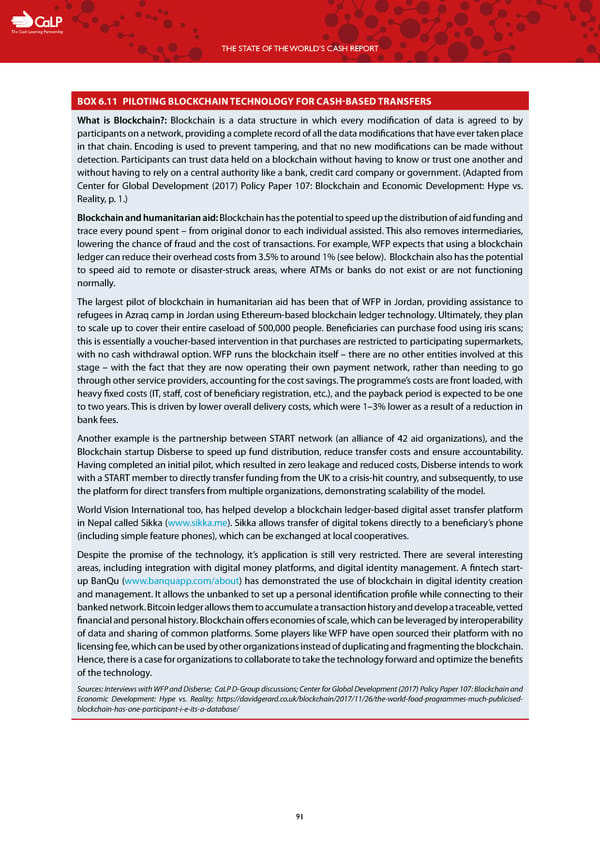C The Cash Learning Partnership THE STATE OF THE WORLD’S CASH REPORT BOX 6.11 PILOTING BLOCKCHAIN TECHNOLOGY FOR CASH-BASED TRANSFERS What is Blockchain?: Blockchain is a data structure in which every modification of data is agreed to by participants on a network, providing a complete record of all the data modifications that have ever taken place in that chain. Encoding is used to prevent tampering, and that no new modifications can be made without detection. Participants can trust data held on a blockchain without having to know or trust one another and without having to rely on a central authority like a bank, credit card company or government. (Adapted from Center for Global Development (2017) Policy Paper 107: Blockchain and Economic Development: Hype vs. Reality, p. 1.) Blockchain and humanitarian aid: Blockchain has the potential to speed up the distribution of aid funding and trace every pound spent – from original donor to each individual assisted. This also removes intermediaries, lowering the chance of fraud and the cost of transactions. For example, WFP expects that using a blockchain ledger can reduce their overhead costs from 3.5% to around 1% (see below). Blockchain also has the potential to speed aid to remote or disaster-struck areas, where ATMs or banks do not exist or are not functioning normally. The largest pilot of blockchain in humanitarian aid has been that of WFP in Jordan, providing assistance to refugees in Azraq camp in Jordan using Ethereum-based blockchain ledger technology. Ultimately, they plan to scale up to cover their entire caseload of 500,000 people. Beneficiaries can purchase food using iris scans; this is essentially a voucher-based intervention in that purchases are restricted to participating supermarkets, with no cash withdrawal option. WFP runs the blockchain itself – there are no other entities involved at this stage – with the fact that they are now operating their own payment network, rather than needing to go through other service providers, accounting for the cost savings. The programme’s costs are front loaded, with heavy fixed costs (IT, staff, cost of beneficiary registration, etc.), and the payback period is expected to be one to two years. This is driven by lower overall delivery costs, which were 1–3% lower as a result of a reduction in bank fees. Another example is the partnership between START network (an alliance of 42 aid organizations), and the Blockchain startup Disberse to speed up fund distribution, reduce transfer costs and ensure accountability. Having completed an initial pilot, which resulted in zero leakage and reduced costs, Disberse intends to work with a START member to directly transfer funding from the UK to a crisis-hit country, and subsequently, to use the platform for direct transfers from multiple organizations, demonstrating scalability of the model. World Vision International too, has helped develop a blockchain ledger-based digital asset transfer platform in Nepal called Sikka (www.sikka.me). Sikka allows transfer of digital tokens directly to a beneficiary’s phone (including simple feature phones), which can be exchanged at local cooperatives. Despite the promise of the technology, it’s application is still very restricted. There are several interesting areas, including integration with digital money platforms, and digital identity management. A fintech start- up BanQu (www.banquapp.com/about) has demonstrated the use of blockchain in digital identity creation and management. It allows the unbanked to set up a personal identification profile while connecting to their banked network. Bitcoin ledger allows them to accumulate a transaction history and develop a traceable, vetted financial and personal history. Blockchain offers economies of scale, which can be leveraged by interoperability of data and sharing of common platforms. Some players like WFP have open sourced their platform with no licensing fee, which can be used by other organizations instead of duplicating and fragmenting the blockchain. Hence, there is a case for organizations to collaborate to take the technology forward and optimize the benefits of the technology. Sources: Interviews with WFP and Disberse; CaLP D-Group discussions; Center for Global Development (2017) Policy Paper 107: Blockchain and Economic Development: Hype vs. Reality; https://davidgerard.co.uk/blockchain/2017/11/26/the-world-food-programmes-much-publicised- blockchain-has-one-participant-i-e-its-a-database/ 91
 The State of the World's Cash | Full Report Page 92 Page 94
The State of the World's Cash | Full Report Page 92 Page 94